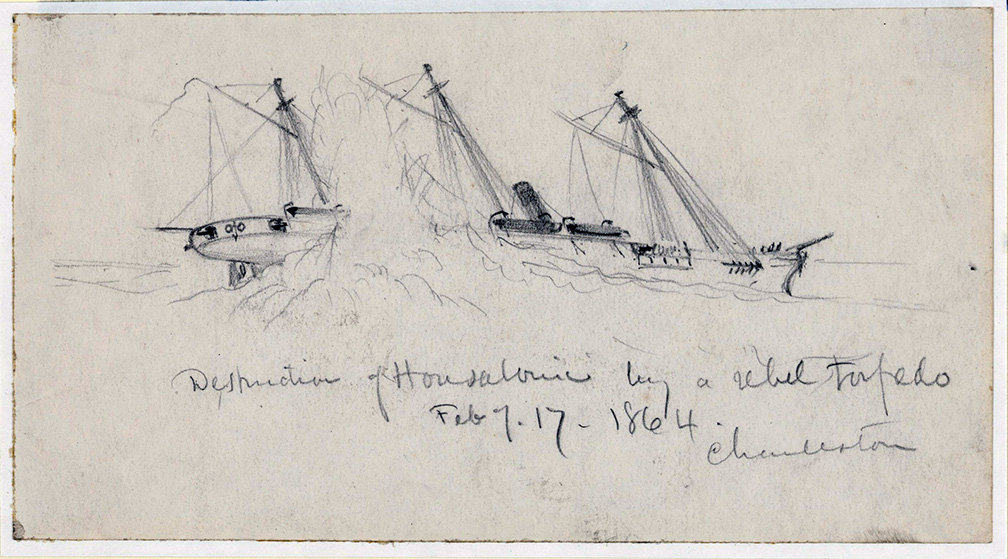
Destruction of USS Housatonic by a rebel torpedo, February 17, 1864. (Sketch by Civil War artist William Waud.)
February 1864
By Phil Kohn
Phil Kohn can be reached at USCW160@yahoo.com
President Lincoln on February 1, 1864, orders 500,000 more men to be drafted for three years or the duration of the war. In North Carolina, fighting breaks out at Bachelder’s Creek, the beginning of Maj. Gen. George Pickett’s attempt to retake Union-held New Bern. The attack ends when the Federals withdraw to their strong inner defenses. In Washington, D.C., the House of Representatives — with Ulysses Grant in mind — votes to revive the army grade of lieutenant general, a rank not used since the time of George Washington.
On February 2, Confederate sailors with Pickett’s force in North Carolina board the gunboat USS Underwriter from small boats in the Neuse River near New Bern, killing the captain and three others, and capturing the rest of the crew. There is some skirmishing between the two armies, but the Federals once again thwart the attack by pulling back into their inner defenses. Pickett gives up on taking the well-defended town and begins retreating.
The Union army on February 3 begins a two-pronged campaign against the Confederate rail center of Meridian, in east central Mississippi. Maj. Gen. William T. Sherman will head east from Vicksburg, Mississippi with 26,000 infantrymen, while Brig. Gen. William Sooy Smith will head southeast from Memphis with 7,600 cavalry. They are to rendezvous on February 10 and then move on to Meridian.
Moving eastward towards Meridian, Mississippi, Sherman’s Union soldiers, skirmishing with Confederates for an 18-mile stretch along the way, reach Jackson, the state capital, on February 5.
Heavy rains and swampy terrain around Memphis delay Sooy Smith’s start. His 7,600 Union cavalrymen ride out only on February 6 — three days late — for their rendezvous with Sherman. They find the going very slow along the way. In Richmond, the Confederate Congress bans the importation of luxury items as well as the circulation of U.S. currency. It also mandates that half of cotton, tobacco, naval stores and certain food shipments must be handed over to the government before ships can leave port.
On February 7, 8,000 U.S. troops under Brig. Gen. Truman Seymour occupy Jacksonville, Florida. Meeting little resistance, they prepare to move inland. In Mississippi, Lt. Gen. Leonidas Polk —aware of the large Union movements towards Meridian — orders Confederate forces there to begin withdrawing.
On the evening of February 9, 109 captured Union officers escape from Libby Prison — a three-story warehouse previously operated by Capt. Luther Libby and his son as a ship chandlery and grocery — at the waterfront of the James River in Richmond, Virginia. The men had laboriously dug a tunnel under and out of the facility. The Confederates round up 48 of the prisoners, including the leader. Two escapees drown, but 59 make it to Federal lines.
In the Indian Territory, a Federal expedition of 450 cavalry troopers from Union-held Fort Gibson in the Cherokee Nation on February 13 reaches Boggy Depot in the Choctaw Nation. Boggy Depot is around 20 miles northeast of Fort Washita, an important Confederate supply depot and military hospital not far from the Texas border.
In Florida, on February 14, Federal troops occupy Gainesville. On the same day, Maj. Gen. William T. Sherman’s force reaches Meridian, Mississippi. Sherman is anxious because Brig. Gen. Smith’s cavalrymen had not shown up at their planned rendezvous four days earlier. Sherman’s men find that their Confederate opponents — who have been steadily withdrawing before their superior numbers, as ordered by Lt. Gen. Leonidas Polk — have destroyed much military equipment and removed anything portable. Sherman has his men destroy much of the rest — as well as the town. He reports: “For five days, 10,000 men worked hard and with a will in that work of destruction . . . Meridian, with its depots, storehouses, arsenals, hospitals, offices, hotels and cantonments no longer exists.”
In Richmond, Virginia, the Confederate Congress on February 15 appropriates $5 million for a “secret service,” of which $1 million is set aside for Canadian-based sabotage operations against the United States. Thomas C. Hines, a former cavalry captain, is assigned to carry out “appropriate enterprises.”
At around 8:45 p.m. on February 17 the first successful submarine attack in history takes place: The Confederate semi-submersible H.L. Hunley attacks USS Housatonic in the waters off Charleston, South Carolina. Housatonic explodes and sinks quickly, killing five. Hunley gets away, but inexplicably sinks on the way back to port with the loss of its entire complement of one officer and six crewmen. Hunley is a costly success: in addition to the loss of the crew involved in the attack, at least 33 men had died testing the vessel.
On February 18, Union soldiers continue their destruction in and around Meridian, Mississippi, and wrecking of railroad lines in its vicinity. Lt. Gen. Sherman remains concerned about Brig. Gen. Smith, as he and his cavalry have still not arrived.
At Olustee, Florida, about 48 miles west of Jacksonville, on February 20, some 5,000 Confederate militia and other hastily gathered troops under Brig. Gen. Joseph Finegan intercept 5,500 Union troops under Brig. Gen Truman Seymour who are moving toward Tallahassee. The resulting battle is the largest fought in Florida and the Union force is soundly defeated, suffering 1,861 killed, wounded, captured and missing. Confederate casualties number 934. Florida’s interior remains under Confederate control for the remainder of the war. In Mississippi, Lt. Gen. William T. Sherman gives up on waiting for Smith and his cavalry and begins moving his troops — who have been sacking Meridian for the past six days and have nothing left to destroy — back westward toward Vicksburg.
On February 21, Brig. Gen. William Sooy Smith’s cavalry force, still slogging its way toward Meridian, with 100 miles yet to go, is fallen upon by the Confederate cavalry of Maj. Gen. Nathan Bedford Forrest at West Point, Mississippi. Pressed hard by Forrest, Smith, with his 7,000 troopers, decides he is outnumbered and will not be able to break through. After some skirmishing, Smith orders his troopers to turn around and retreat towards Memphis.
The next day, February 22, Forrest’s cavalry hits the retreating Union force of Smith hard yet again at Okolona, Mississippi, about 28 miles north of West Point. After a six-hour-long fight, often hand-to-hand, Forrest’s 2,500 troopers soundly trounce Smith’s 7,000 Federal cavalrymen, capturing six guns and 33 stands of colors (battle flags). Smith’s troops manage to get away and finally straggle back into Memphis on February 26. Smith will be censured by Sherman for his lack of performance and he will resign from the army on 15 July 1864. In Tennessee, Maj. Gen. George Thomas’s Army of the Cumberland begins a reconnaissance of Gen. Joseph Johnston’s Army of Tennessee, in winter quarters at Dalton, Georgia. Thomas is trying to determine if Johnston has weakened his force by reinforcing either Polk or Longstreet, or both. In Washington, Secretary of the Treasury Salmon P. Chase once again submits his resignation, which is again rejected by President Lincoln. This time, the issue is the “Pomeroy Circular,” a document supported by some Radical Republicans and violent abolitionists who are opposed to Lincoln’s reelection. Signed by Sen. Samuel Pomeroy of Kansas, the circular advocates for Chase to become president. Chase denies knowledge of the circular, although some evidence indicates he not only knows about the document but approved it.
In Richmond, on February 24, Jefferson Davis — in another unpopular move and to the consternation of many in the army — makes Gen. Braxton Bragg his military advisor, “in charge of the military operations of the Armies of the Confederacy.” In effect, Bragg becomes Davis’s military chief-of-staff. Lt. Gen. James Longstreet comments that, in elevating Bragg (who resigned from command after his defeat at Chattanooga), Davis is approving failure and disparaging success. In Washington, D.C., the Senate joins the House move earlier in the month to revive the army grade of lieutenant general.
Union troops of the Army of the Cumberland try to force their way through Buzzard Roost Gap, near Dalton, Georgia, on February 25, but are held off by a strong Confederate resistance. Two more attempts, against the Confederate right and center, both fail, with the latter effort incurring heavy casualties. It can clearly be seen that Johnston’s Army of Tennessee is not weakened, and Thomas calls the reconnaissance operation off.
On February 27, the first enlisted Union soldiers begin arriving as prisoners of war at unfinished Camp Sumter (better known later as Andersonville), outside of Americus, Georgia, in the southwest portion of the state. The recent escape of prisoners from Libby Prison in Richmond has reinforced to the Confederates the need to remove prisoners from proximity to the front lines.
A U.S. cavalry force of about 3,500 troopers under Brig. Gen. Judson Kilpatrick, with Col. Ulric Dahlgren as second in command, leaves Ely’s Ford, Virginia, on the Rapidan River, on February 28. The plan — authorized by President Lincoln and Secretary of War Stanton— is to launch a surprise attack on Richmond, seize the city and free Federal prisoners held there. As a diversion, Brig. Gen. George Armstrong Custer simultaneously leads a Union cavalry raid into Albemarle County, Virginia, about 80 miles northwest of Richmond.
On February 29, having reached Spotsylvania, Virginia, Kilpatrick splits his force, sending 500 troopers with Col. Dahlgren toward Goochland, Va., about 30 miles west of Richmond, while keeping his main force with him heading directly south towards the Confederate capital. During the evening, the Confederate War Department learns of the impending raid and orders appropriate emergency measures taken. In Washington, President Lincoln approves the Congressional act of reviving the army grade of lieutenant general.







